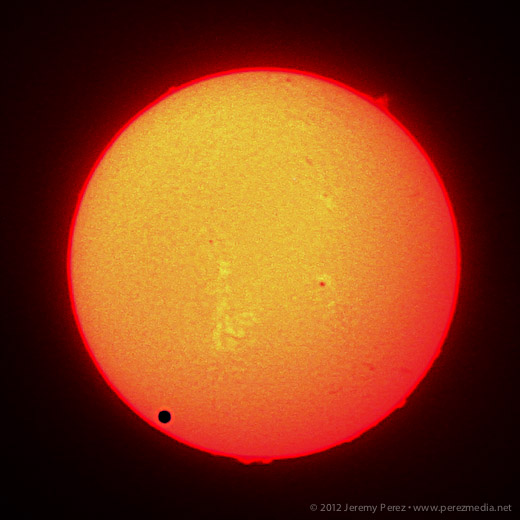Wow! Two amazing solar events within a couple weeks of each other–Annular Eclipse and Venus Transit!
The first bookend Venus transit occurred during the summer of 2004, a couple months before I got my first telescope and actually started getting out to observe amazing events like this. So I missed it that one. Fortunately, the skies were clear over Flagstaff for the second bookend in 2012. We had a perfect back yard view from first contact, until the sun set behind Mt. Elden.
I had the 8-inch Dob set up with a Baader white light filter, and the PST for H-Alpha. Both views were excellent. I tried to get everything set up a couple hours early so I could test the cameras and start prepping sketches of the white light and H-Alpha features. The sun had loads of detail on display on both the photosphere and chromosphere–a whole mess of sunspots, prominences, and plage/faculae. So Venus had a wonderfully intricate backdrop to drift through.
With all the back and forth between scopes and eclipse glasses, sketching, photographing, video recording, wiping dust off everything as the wind gusted, I was kind of scattered…which means I’m glad I had three and a half hours to try and get it right. I was working to finish up my H-Alpha solar disc drawing as first contact time approached, so I wasn’t completely keyed in to the exact moment contact. I first noticed the tiny bite of Venus at 3:07 PM (22:07 UT).
As it slid into the Sun’s disc, I looked for the aureole effect in white light through the Dob, and finally noticed a very faint, very thin hook of dull gray cupping Venus’ dark limb. That became two hooks, and finally a full but tenuous arc–more noticeable close to the limb of the sun, and less defined at the apex of the arc. It was a very subtle effect, and only visible intermittently when the gusting wind paused long enough for the scope to stop bouncing around.

White Light Sequence of the Venus Transit from first to second contact- June 5, 2012, 22:08-22:24 UT
As Venus approached second contact, I looked for the black drop illusion, and noted about a 30 second period where the edge of the sun appeared to pull in toward Venus’ disc. This pulled-in region did not appear as solid as Venus–more of a very dark gray instead of black. I’m not sure whether the effect is created by sub-par optics, or if it is a purely visual trick, but it was fascinating to witness.
As Venus slid across the Sun, I used sunspot alignments to estimate its position at a few intervals. At 4:17 PM MST, as I was observing through the PST, I noticed that some of the plage on the preceding side of AR11498 looked particularly bright and crisp. I had not yet observed a solar flare, but thought this might be one, so I updated that section of the sketch and plotted venus on the solar disc at that point in time to capture my favorite segment of the H-Alpha view. The SolarSoft site shows that a C1.0 class flare was indeed occurring at AR11498 between 4:06 and 4:26 PM local time (23:06-23:26 UT). Pretty cool!

H-Alpha Digital Illustration of the Venus Transit – June 5, 2012, 23:17 UT
Move mouse over image to view labels
Click for larger version.

White Light Sketch of the Venus Transit – June 6, 2012, 00:00 UT
Move mouse over image to view labels
Click for larger version.
The eclipse glasses provided a nice view too, and showed the Sun with a small, black freckle on it’s northern hemisphere.
By 6:15 PM, the Sun was approaching the steep slope of Mt. Elden, and I had to move the scopes around to get clear of]]=some nearby trees. Elden’s silhouette was awesome–a couple gnarly ponderosas and an old broken snag managed to be in just the right spot to put a cool bite into the setting sun. I made the mistake of shooting a couple white-light photos of the silhouette and then hopping over to the PST to shoot some video. I should have just worked on the white light photos and gotten a full setting-sun sequence that I could have animated later.

Ponderosas on the slope of Mt. Elden silhouetted against the Sun with Venus in transit – June 6, 2012 – 01:25 UT
It was a beautiful event–I’m glad the sky cooperated.





Glad to hear a few other folks saw the atmosphere. I was not looking for it, just waiting for the black drop. But there it was, a beautiful ring completing the disk of Venus. One of the most memorable sights I have ever seen in a telescope. Never did see the black drop, the seeing was too good for much of an effect.
Thanks for the confirmation Andrew! I enjoyed your report as well–you did a lot of great outreach work up there! (Andrew’s amazing transit report from the Keck Observatory